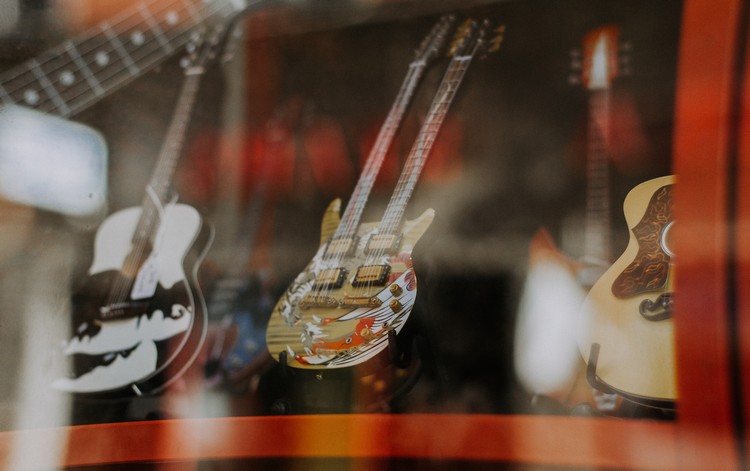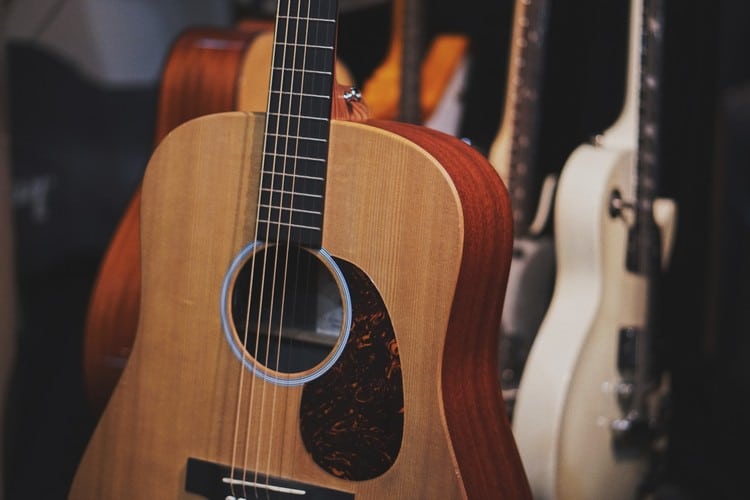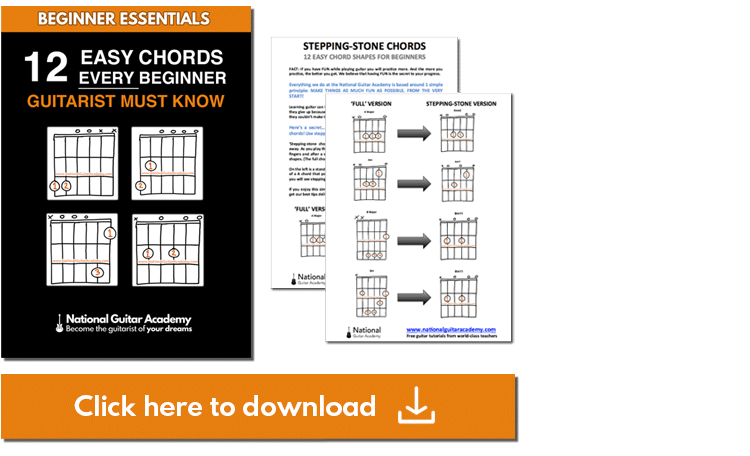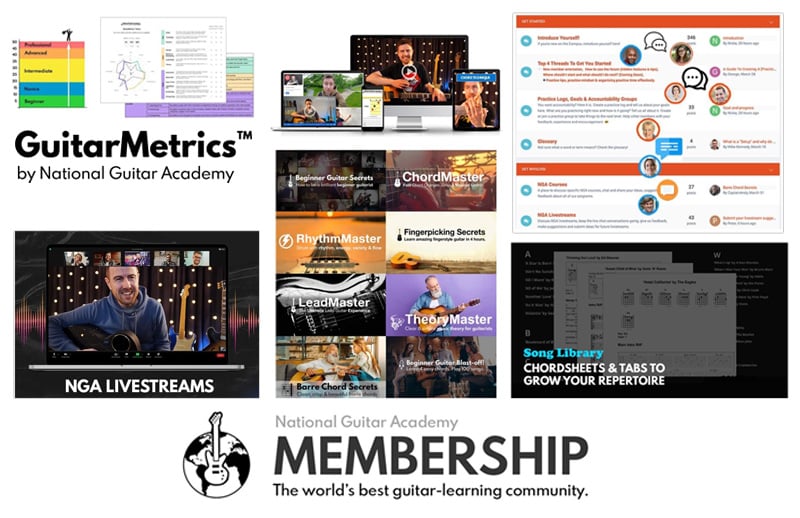Guitar scale exercises can help supercharge our soloing – Let’s find out how!
Over 100,000 guitar-learners get our world-class guitar tips & tutorials sent straight to their inbox: Click here to join them
In this free lesson you will learn…
- 4 powerful guitar scale exercises
- How to explore the key of G major
- Tips for accurate playing using alternate picking
- How to navigate a scale shape in 4 different ways
An Overview Of Guitar Scale Exercises
An often-overlooked part of effective practice is the process of learning how to navigate a scale in multiple ways.
- When we play a guitar solo, we don’t want to simply play the notes of the scale up and down – We want to learn how to play these notes in a variety of different ways.
- Learning scales in this way gives us more access to our scales, and more room to play with our musical vocabulary.
This lesson in guitar scale exercises is designed to break down any barriers you have that are blocking you from maximizing the scales you already know.

In this series of guitar scale exercises , we are going to be playing in the key of G major.
- We chose this key because it has one sharp note – F#. This will give us a bit of variety in our note choice, and will help us break away from playing in C major.
- But why can’t I just play up and down the scale to learn how to play it?
- Great question! Learning different ways to navigate different musical scales gives us more access to their tone and character.
The simple act of playing up and down a scale doesn’t possess much musicality. We want to learn how to play creatively when we perform these scales.
Let’s elaborate on that below!

Why Are Guitar Scale Exercises Important?
Our fingers learn and memorize what we tell them to, which is great – most of the time.
The negative half of that is that if we don’t teach them anything new, they will repeat the same actions they know.
- This can lead to repetition in our playing, and we want you to be able to keep your guitar chops extra-fresh.
- In this lesson, you are going to learn to play guitar scale exercises that will teach you to play in note groupings of three and four.
You will also learn the art of skipping notes and targeting specific intervals on the scale.

Does it sound complicated? It really isn’t, and we’re going to tell you why:
These guitar scale exercises are all made in the name of cracking the code on the musical scales we already know how to play.
The more variety we have in our approach, the more creative we are able to be with the way we play – and who doesn’t love creativity?
The best part about this free lesson?
We can apply these principles to every scale we know.
Let’s talk about why this is so crucial to our creativity below.

Download our lead guitar cheat-sheet to make things easier
It's hard to understand which scales work with which keys.
So we created a cheat-sheet! A key and scale-finder that you can use again and again.

Get your personalised guitar-learning plan 🎸
Get a custom guitar-learning plan here: Click here for GuitarMetrics™
World-Class Guitar Courses 🌎
Learn from the world's best guitar educators: Click here for our guitar courses
Finding Many Ways To Play One Scale
An average of seven notes per scale can seem super limiting at first.
When you think about it on the whole however, we only have twelve notes in total anyway.
So how are all these guitarists finding all these different ways to play the same notes?
The answer: Mastery.
This lesson in guitar scale exercises is designed to help you master the scales you know by giving you different approaches that you might not have already thought of.
By learning how to leap from one scale degree to another as well as approach a scale with different note-groupings, we can begin to pull out all that luscious colour.

Pro Tip: To get the most out of this lesson, we recommend practicing these guitar scale exercises three ways:
- First, practice them freely and without any time feel. Focus on playing each note confidently and with intention so that they each sound out properly.
- Once you feel good about it, turn on a metronome and practice at a rhythm that is comfortable for you. Only increase the tempo when you feel like you need to.
- Practice these guitar scale exercises over a backing track.
This three-step practice method takes us through all the necessary steps to get these routines under our fingers and into our eardrums.
Make use of it to help yourself hash out the difficult parts of this lesson!

The Benefit Of These Guitar Scale Exercises
Your hands may yell at you first, but they’ll thank you later when they are able to run these scales with minimal effort.
Some of the most challenging guitar scale exercises tend to take us the farthest in our playing, and this lesson is no exception.
- As guitarists (as well as musicians), it’s important for us to constantly try to push our musical boundaries to improve.
- Comfort is the enemy of progress, so don’t let yourself get too comfortable with the things you already know.
Seek out the things you don’t know and you’ll never be bored!

The Importance Of Stretching First
Your hands will yell at you more if you don’t stretch before performing these guitar scale exercises.
Playing complex lines of music that challenge our hands is fantastic, but without proper stretching we can leave ourselves open to injury.
- Strains and hyper-extensions can be common for those who don’t stretch, and these can set us back pretty far if not taken seriously.
- It’s important to put the safety of our hands, wrists and forearms first in order to give ourselves a long, healthy life of guitar playing.
- If you feel any discomfort throughout these guitar scale exercises, put the guitar down and stretch.
If it persists, put the guitar down and see your doctor.
Check out this video from GuitarLessons365 on proper stretching practice to keep your hands limbre and ready to shred!

Guitar Scale Exercises I – Three-Note Groupings
As discussed, there are a variety of ways to approach any scale. One key approach is in groups of three notes at a time.
- For this example, we’re going to use the G major scale.
- We begin from the first note and play the second and third.
- From there, we step back to the second note of the scale and play the third and fourth as well.
This process continues to the top of the scale.
These types of guitar scale exercises are a fantastic way to hear the details of a scale, as well as a great soloing technique to adapt for our playing.

We can descend the G major scale in the same fashion as we ascended it – three notes at a time.
Make sure to make use of alternate picking to get the smoothest possible sound from your playing.
Alternate picking is a fantastic approach that not only helps keep things sounding crisp, but also lets us hear our mistakes easier. Always pay attention to what and how you’re playing!
Pro Tip: These guitar scale exercises are fantastic practice with a metronome, and will really help to keep both of your hands on their toes at all times.
Make sure to jam this scale approach over a backing track to really hear what you are playing in a musical context.

Guitar Scale Exercises II – Four-Note Groupings
Much like the three-note groupings drill above, four-note groupings are another excellent way to navigate a musical scale.
- Instead of stopping at the third scale degree, we stop once we have reached the fourth.
- From there, we begin again at the second scale degree and play to the fifth, then the third to the sixth, and so on.
The back-and-forth momentum that is required to play these guitar scale exercises effectively really lets us bounce between notes once we have it mastered and under our fingers.
Make sure to take your time with this drill.

Pro Tip: We included three and four-note groupings in this guitar scale exercises lesson because they are known as even groupings. This means that they play well in a 4/4 time signature.
Groupings like five and seven are known as odd groupings and have not been included because they don’t play well in 4/4 time.
Challenge: These odd groupings can be played over 4/4, but only over multiple bars of music.
This is known as a polyrhythm. For example, four five-note groupings would fit overtop of five bars of 4/4 because both would translate to 20 beats of music.
4×5 = 20
5×4 = 20
See how it works? Try this with a metronome at a slow and manageable speed to see if you can evenly divide four five-note groupings over five bars of music. Use your metronome!
Pro Tip: Dividing guitar scale exercises into different note groupings is a great way to expand on exercises you already know!

Guitar Scale Exercises III – Moving In Thirds
To clear up any confusion right away, thirds and three-note groupings are not the same thing.
While a three note grouping involves playing three notes at a time, thirds imply moving a third interval away from a note.
For example: Below are the notes of the G major scale:
G A B C D E F# G
I II III IV V VI VII VIII/I
In this example, the ascending order of our notes in the scale will look like this:
G B A C B D C E D F# E G
Check the tab below and say the notes out loud as you play them (as you should with all of these guitar scale exercises):

In the descending version of these guitar scale exercises, the order of our notes will look like this:
G E F# D E C D B C A B G
Pro Tip: This exercise as well as the next will help us to find new ways of jumping between notes inside of a scale’s box shape.
This is incredibly important for helping us develop a sense of expression inside the confines of four frets before we learn how to break out of those shapes.
Once we learn how to navigate a scale across twelve frets, these guitar scale exercises will come in especially handy.
Writer’s Note: If you haven’t taken much time to stretch throughout this lesson, now would be a good time to take a quick break before this last drill.

Learn 12 EASY beginner chords with our popular guide

✅ Stop struggling. Start making music.
✅ Learn beginner-friendly versions of every chord.
This is our most popular guide and it will improve your chord ability quickly! 😎
Get your own personalised guitar-learning plan 🎸
Get a custom guitar-learning plan here: Click here for GuitarMetrics™
World-Class Guitar Courses 🌎
Learn from the world's best guitar educators: Click here for our guitar courses
Guitar Scale Exercises IV – Moving In Fifths
Fifth intervals are referred to as stable intervals – meaning that there is never a bad time to play one.
- Fifth intervals function perfectly and compliment the note prior to them extremely well.
- Learning to play in fifths is a skill that can really jumpstart our approach to guitar scales and get us thinking outside of the box.
Once again, let’s take a look at our G major scale:
G A B C D E F# G
I II III IV V VI VII VIII/I
Now let’s look at the G major scale played in fifths:
G D A E B F# C G D A E B F# C G
Do you see the pattern? Let’s play it for clarity. Say the notes out loud as you play them.

The final example in this guitar scale exercises lesson gets us to descend the scale in fifths.
Our order of notes looks like this:
G C F# B E A D G C F# B E A D G
Pro Tip: We can apply these guitar scale exercises to every key – and we should.
A common practice in the Jazz guitar world is to practice musical concepts in as many different keys as possible to master them. This is a practice principle that every guitarist can benefit from.

Bonus Pro Tip: We don’t need to limit ourselves to just this one box shape.
In fact, if we really want to broaden our horizons, we shouldn’t limit ourselves at all.
Practice these guitar scale exercises in as many different positions across the G major scale as you can to master these finger drills and expand your guitar horizons!
We’ve included a map of the G major scale fretboard so that you can do some exploring of your own. Try and find as many different ways to play through this scale as you can!

For info on how to incorporate daily practice, check out this article from Guitar Gear Finder!
Where Do I Go From Here?
Want more out of these guitar scale exercises? We recommend these next steps:
- Try playing these exercises in every key
- Practice moving in fourths along the scale shape
- Practice to a metronome
- Instead of practicing on every beat, play only on beats 2 & 4 or the metronome – This creates a different type of rhythm to practice
- Practice these note-skipping techniques over a backing track!
Recommended Resources
If you enjoyed this free lesson from National Guitar Academy, we’ve got plenty more in store for you below!
- Guitar School
- Blues Guitar For Beginners
- Guitar Music For Beginners – 10 Tracks That Sound Amazing
- Guitar Arpeggios
- Guitar Chords – The Ultimate Guide
What Type of Guitarist Are You?
Take our 60-second quiz & get your results: Take The Quiz
Join the world's best online guitar school 🌎
- Get your own personalised guitar learning plan (customised just for YOU).
- World-class online guitar courses. Learn at your own pace.
- Community Campus & Learning Forum - A friendly community! Connect with our team & students. 😊
- Beginner Song library with chordsheets, tabs and tips. (Songs suitable for all levels!)
- Regular live streams, seminars and Q&A sessions - Learn from world-class guitar educators. Get all your questions answered!
Click here to learn more about National Guitar Academy membership 
Cool Guitar T-shirts 😎
Look cooler! Check out our merch: Click here to see our merch store
Want free guitar tips and video lessons delivered to your inbox?
Join over 100,000 guitar-learners and subscribe to our guitar-tips-by-email service. (It's free.)
We'll send you a series of lessons that will move you to the next level of your guitar journey.
Learn how everything fits together quickly, easily and effectively. We share ninja tips (for instant fun!) but also timeless fundamentals that will deepen your understanding.

Popular Lessons
How To Learn Guitar: An 11-Step Programme For Beginners
How To Choose The Perfect Beginner Guitar
More Cool Guitar Stuff
Learn about National Guitar Academy: About Us
Join us on Facebook for daily guitar tips.
Listen to our Learn Guitar Podcast for rapid guitar progress.
Check out our free chord lessons.
Get our best guitar tips & videos
Where should we send it?
Where should we send it?
Get our best guitar tips & videos

